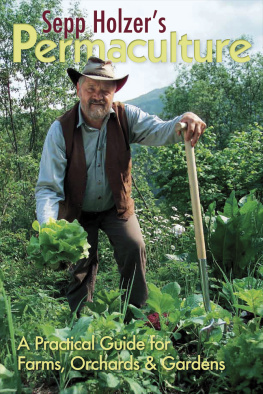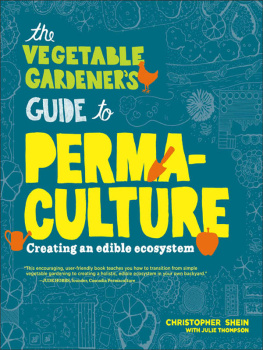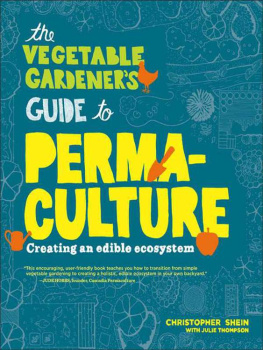praise for
Sepp Holzers Permaculture
A fascinating book written by a man who has devoted a lifetime to working with nature and creating extraordinarily diverse polycultures. His work is breathtaking.
Maddy Harland,
editor of Permaculture Magazine
At an altitude that everyone else has abandoned to low-value forestry, [Sepp Holzers] is probably the best example of a permaculture farm in Europe [and] stands out like a beacon.
Patrick Whitefield,
permaculture author and teacher
As the era of cheap energy, stable climates, and surplus fertilizer stocks comes to a close, the principles of permaculture will become increasingly attractive as one way to design our future food and agriculture systems. This book provides important insights for applying these principles, for both rural farming and emerging forms of urban agriculture.
Frederick Kirschenmann , president of
Stone Barns Center for Food and Agriculture
Sepp Holzer is a Superstar Farmer who turns out an absolutely remarkable volume and variety of food products without one smidgen of chemical fertilizer, and on land in Austria that an Illinois corn farmer would pronounce too marginal for agriculture.
Gene Logsdon , author of Holy Shit: Managing Manure
to Save Mankind and The Contrary Farmer
Heres great news for fruit-loving gardeners everywhere! Most of the work of establishing, pruning, and tending fruit trees by modern methods is unnecessary and even counterproductive. This book is The One-Straw Revolution for tree crops.
Carol Deppe , author of The Resilient Gardener:
Food Production and Self-Reliance in Uncertain Times
Sepp Holzers
Permaculture
A Practical Guide for
Farmers, Smallholders and Gardeners
Published by
Permanent Publications,
The Sustainability Centre, East Meon,
Hampshire GU32 1HR
United Kingdom
www.permaculture.co.uk
Distributed in the USA by
Chelsea Green Publishing Company
www.chelseagreen.com
2004 by Leopold Stocker Verlag
First published in German as Sepp Holzers Permakultur by
Leopold Stocker Verlag, Hofgasse 5, PO Box 438, A-8011 Graz, Austria
First English language edition @ 2010 Permanent Publications
The right of Sepp Holzer to be identified as the author of this work has been asserted by him in accordance with the Copyrights, Designs and Patents Act 1998.
Translated from the German by Anna Sapsford-Francis
Designer: Two Plus George Limited
www.TwoPlusGeorge.co.uk
British Library Cataloguing-in-Publication Data
A catalogue record for this book is available from the British Library
EPUB ISBN 9781856230858
All rights reserved. No part of this publication may be reproduced or transmitted in any form by any means without prior permission in writing from the publisher, Hyden House Ltd.
Contents
In the film Sepp Holzers Permaculture theres an image that really says it all. Taken from the air, it shows steep mountainsides covered in seemingly endless monocultures of spruce trees, broken only by the mountainside that is Sepp Holzers farm, the Krameterhof. In contrast to the dark trees on either side, its an intricate network of terraces, raised beds, ponds, waterways and tracks, well covered with fruit trees and other productive vegetation and with the farmhouse neatly nestling amongst them. There, at an altitude which everyone else has abandoned to low-value forestry, what is probably the best example of a permaculture farm in Europe stands out like a beacon. It stands as witness to both the contrariness and the skill of the Rebel Farmer.
He has always gone against the grain of modern farming: he cultivates rich mixtures of plants and animals in place of monocultures; he has no need for chemicals because the dynamic interactions between the plants and animals in his polycultures provide all the services which conventional farmers find in the fertiliser bag and the crop sprayer. But it takes more than a contrary nature to be a rebel farmer. It also takes skill and knowledge, and these dont come easily. Right from his childhood, when his mother gave him a small plot for his first garden, he has observed, questioned, experimented, observed again and experimented again. He knows the natural world like few other people do today, and treats his farm as an integrated part of that natural world which is exactly what it is.
In this book he shares the skill and knowledge which he has acquired over his lifetime. He covers every aspect of his farming, not just how he creates a holistic system on the farm itself but also how he makes a living from it. He writes about everything from the overall concepts which guide him down to the details, such as which fruit varieties he has found best for permaculture growing. Farming at such a high altitude is a challenge in itself, and as well as his knowledge of plant and animal interactions he has had to learn much about how heat and water pass through the ecosystem, and how they can be stored and made to work for the system.
An important part of permaculture is getting to know your own individual place. Every patch of the Earth has its unique personality and character, just as each person has. Nevertheless Sepp Holzer has taken his skill and applied it on sites all over the world and in urban gardens too. It takes a great deal of experience to be able to look at a site in a different part of the world and understand how it works well enough to be able to give advice on it.
The other side of that coin is that what works for him on his Austrian mountain will not necessarily work for you on your own land. Here in Britain, for example, we have a cloudy maritime climate, in strong contrast to Austrias continental climate. Although our winters are milder, so too are our summers. Above all we lack the sunshine which is such a key element in the way he creates favourable microclimates. Humidity is also greater here. What you can do, say, at 250m on the edge of Bodmin Moor is not the same as what you can do at ten times that altitude on the Krameterhof. Similar allowances must be made for other parts of the world.
This is not to negate the value of this book for people who live outside Austria far from it. Much of the detailed information is highly relevant in any temperate country. As long as you bear in mind that both your climate and your soil are possibly quite different to those on the Kameterhof, you will find it a storehouse of valuable information.
Nevertheless the books greatest value is not so much in the information it contains but in the attitudes it teaches. Its message is not so much this is how you do it but this is the way you go about thinking of how to do it. Sepp Holzers way is the way of the future. In the fossil fuel age weve been able to impose our will on the land by throwing cheap energy at every problem. In the future that option wont be open to us any more. Well have to tread the more subtle path, the path which patiently observes nature and seeks to imitate it. That future may not be as far off as we think.
Patrick Whitefield
September 2010
Patrick Whitefield is a permaculture teacher and the author of Permaculture in a Nutshell (1993), How to make a Forest Garden (1996), The Earth Care Manual (2004) and The Living Landscape (2009). More details about his courses can be found at www.patrickwhitefield.co.uk
Dear readers,
This is the second book I have written so far, to pass on my over 40 years of experience as a farmer practising alternative agriculture. I was inspired to do this by the many people who have come to visit the Krameterhof: among them teachers, professors and doctors as well as farmers and gardeners. My darling wife, Vroni, and my children were particularly eager for me to put my experiences and discoveries into writing. My first book, an autobiography entitled The Rebel Farmer , sold over 120,000 copies in just under two years and was a great success. It was presented with a golden book award and I received well over a thousand letters from enthusiastic readers. This made me realise that there was a great deal of interest in my work. When my daughter Claudia and son Josef Andreas offered their help, I simply could not refuse.













